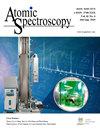用电子探针微量分析高精度测量月球玻璃中微量Na、K、P、S、Cr和Ni
IF 2.3
2区 化学
Q1 SPECTROSCOPY
引用次数: 2
摘要
月球玻璃可以提供关于月球岩石起源和月球内部演化的重要信息。电子探针微分析(EPMA)可以测量月球玻璃中的Na、K、P、S、Cr和Ni等微量元素,为了解玻璃类型、撞击挥发和岩浆演化过程提供信息。然而,这些微量元素在玻璃中的分析准确性和精密度会受到光束灵敏度、x射线峰移和二次荧光效应的影响。利用EPMA技术,构建了一种准确度和精密度高的优化分析方法,可同时分析月球玻璃中的微量元素和主要元素。该方法是利用中国科学院地质与地球物理研究所的CAMECA sx5 EPMA开发的。月球玻璃中Na、K、P、S、Cr和Ni的最佳分析条件为:加速电压20 kV,束流100 Na,束流直径10 μm,线性背景模式,采用大面积分析晶体和聚集计数策略,总计数时间10 min。玄武岩和科马地岩玻璃标准品的重复分析表明,分析结果与参考值一致。所分析的微量元素含量的变化在±10%以内。对Na、K、P、S、Cr、Ni的检出限(3σ)可降至17 ~ 96 ppm。我们的方法即使在10分钟的分析时间后也可以防止样品损坏。因此,该优化方法可以对月球玻璃进行精确的痕量和主元素分析,有助于追溯其来源。本文章由计算机程序翻译,如有差异,请以英文原文为准。
High-Precision Measurement Of Trace Level Na, K, P, S, Cr, And Ni In Lunar Glass Using Electron Probe Microanalysis
: Lunar glass can provide critical information on the genesis of lunar rocks and the evolution of the Moon's interior. Several minor and trace elements in lunar glass, such as Na, K, P, S, Cr, and Ni, can be measured by electron probe microanalysis (EPMA) and are informative for understanding glass type, impact volatilization, and magmatic evolution processes. However, the analytical accuracy and precision of these trace-level elements in glass can be impeded by beam sensitivity, peak shift of X-ray and secondary fluorescence effects. Using EPMA, we constructed an optimized analytical method with high accuracy and precision to analyze trace elements simultaneously with major elements in lunar glass. The method was developed using the CAMECA SXFive EPMA at the Institute of Geology and Geophysics, Chinese Academy of Sciences (IGGCAS). The optimal analytical conditions for Na, K, P, S, Cr, and Ni in lunar glass were as follows: 20 kV accelerating voltage, 100 nA beam current, 10 μm beam diameter, linear background mode, using large-area analytical crystals and aggregate counting strategy and a 10-min total counting time. Replicate analyses on basalt and komatiite glass standards show that the analytical results are consistent with the reference values. Variations in the levels of the analyzed trace elements fall within ± 10%. The detection limits (3σ) for Na, K, P, S, Cr, and Ni can be lowered to 17-96 ppm. Our method can prohibit sample damage of lunar glass even after a 10-min analysis time. Therefore, this optimized method can provide precise trace and major element analysis of lunar glass and help to trace its origin.
求助全文
通过发布文献求助,成功后即可免费获取论文全文。
去求助
来源期刊

Atomic Spectroscopy
物理-光谱学
CiteScore
5.30
自引率
14.70%
发文量
42
审稿时长
4.5 months
期刊介绍:
The ATOMIC SPECTROSCOPY is a peer-reviewed international journal started in 1962 by Dr. Walter Slavin and now is published by Atomic Spectroscopy Press Limited (ASPL). It is intended for the rapid publication of both original articles and review articles in the fields of AAS, AFS, ICP-OES, ICP-MS, GD-MS, TIMS, SIMS, AMS, LIBS, XRF and related techniques. Manuscripts dealing with (i) instrumentation & fundamentals, (ii) methodology development & applications, and (iii) standard reference materials (SRMs) development can be submitted for publication.
 求助内容:
求助内容: 应助结果提醒方式:
应助结果提醒方式:


